(2: 福建师范大学地理科学学院, 福州 350007)
(3: 福建师范大学亚热带湿地研究中心, 福州 350007)
(2: School of Geographical Sciences, Fujian Normal University, Fuzhou 350007, P.R.China)
(3: Research Centre of Wetlands in Subtropical Region, Fujian Normal University, Fuzhou 350007, P.R.China)
水产品作为全球人类食物蛋白质的第三大来源,在未来全球粮食安全中发挥日益重要的作用[1]. 但由于当前全球海洋渔业捕捞趋于稳定,人类对水产品日益增长的需求更多地通过水产养殖来满足[2-3]. 据FAO统计,近20年以来,全球水产养殖年增长速率约为5.8 %,其在总渔业生产中的贡献率由2000年的25.7 % 提高到2018年的46.0 % [1]. 在全球水产养殖中,围垦养殖是亚太地区发展中国家的一种重要水产品生产方式[4]. 中国是世界上最大的水产养殖生产国,其滨海围垦养殖塘面积已从1984年的2612 km2增加到2016年的13075 km2[5]. 然而,这些养殖塘系统结构相对简单、自适应能力较差,养殖过程中人工投入的大量营养物质被有限利用,加上养殖动物自身排放的排泄物,可使大量有机物残留在养殖池塘内,易造成水体富营养化和水质恶化,引起病原体滋生,降低水产品产量和质量,影响渔业可持续发展[6-8]. 有关滨海养殖塘水环境质量评价及优化调控的研究日益受到关注.
初级生产力是浮游植物等初级生产者在单位面积水域与单位时间内生产有机物质的量,作为养殖塘生态系统食物链的基础环节[9],常被用来反映养殖塘物质循环和能量流动速度及评价池塘营养状态[10]和预测水域水产品生产力[11]. 因此,系统研究养殖塘生态系统的初级生产力,掌握其时空变化特征及其影响因素,对评价养殖塘水环境质量和指导渔业可持续生产具有重要价值[9, 12],同时对了解养殖塘系统生态功能特征具有十分重要的意义. 在过去数十年中,尽管国内外已开展系列关于养殖系统水体初级生产力特征及其影响因素的相关研究[9, 12-16],但对于滨海海水养殖方式下陆基水产养殖塘的研究鲜见报道. 此外,国内的相关研究工作在地域上主要集中于北方地区,对于南方地区高密度、半集约化及集约化养殖方式下的养殖塘水体初级生产力变化特征关注较少. 积极开展不同地域、不同养殖对象及不同养殖模式下的养殖系统初级生产力研究,既是为完善我国水产养殖技术和渔业发展规划提供基础资料,也是为深入开展养殖塘生态系统碳、氮等生源要素物质循环及其生态效应研究提供理论知识[14].
福建省是全国滨海水产养殖的主要区域之一,其半集约化及集约化等方式下的虾塘养殖面积居全国第四位[17]. 但是,目前十分缺乏福建省沿海地区养虾塘水体初级生产力研究方面的基础数据. 鉴于此,本文通过对福建省闽江河口鳝鱼滩湿地3个陆基海水养虾塘水体在养殖期间的初级生产力进行了逐月测定和分析研究,旨在揭示同种管理方式下养虾塘间的水体初级生产力差异性、时间变化特征及其主要影响因素,以期为当地养殖生产过程中水环境调控和促进养殖业可持续发展提供基础数据和参考资料.
1 材料与方法 1.1 研究区域概况鳝鱼滩湿地(26°0′36″~26°3′42″N, 119°34′12″~119°40′40″E)地处福建省闽江河口区南端(图 1),其面积约为3120 hm2. 该湿地所在区域属于中亚热带与南亚热带海洋性季风气候的过渡地带,年平均气温和降水量分别为19.7℃和1346 mm,气候温暖湿润[18]. 鳝鱼滩湿地外围主要由沙滩和泥滩组成,其潮汐特征表现为正规半日潮. 土著种芦苇(Phragmites australis)、短叶茳芏(Cyperus malaccensis)及入侵种互花米草(Spartina alterniflora)为区域内优势湿地植物[19]. 2012年基于治理外来入侵种互花米草及构建候鸟栖息地的目的,鳝鱼滩中部的中高潮滩区段一些潮汐沼泽湿地被围垦为陆基水产养殖塘[20]. 该区域养殖塘于每年5—11月主要开展水产养虾活动,其余时间池塘主要进行排水晒塘管理[21]. 养殖期间,池塘内的水体主要源自于河口潮水和大气降水.
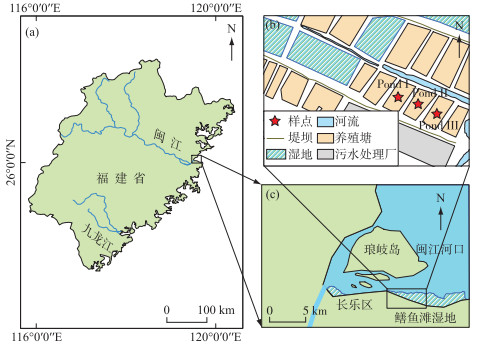
|
图 1 研究区域位置与采样池塘 Fig.1 Location of study area and the sampling ponds in the Minjiang River estuary |
随机选取研究区域内3个养殖塘(分别标记为PondⅠ、PondⅡ和PondⅢ)(图 1)作为本研究实验样地. 所选取的养殖塘基本信息见表 1[17]. 于2018年5—10月的整个养殖期内,每月对选取的养殖塘进行2~3次样品采集与测试工作. 为方便采样并减少人为干扰的影响,在每个养殖塘内搭建一座栈桥(长×宽=10 m×1.0 m),沿着从池塘岸边到中央方向进行采样. 于每个池塘搭建的栈桥上布设5个采样点. 鉴于养殖塘养殖期间平均水深仅有1.5 m,本研究选取表层(距水面以下10~20 cm深度)和底层(距池塘底部10~20 cm)作为每个样点水样采集与测定的深度. 根据虾的体重、投饵量的变化,并参考Páez-Osuna等[22]和Yang等[23]的研究报道,3个养虾塘的养殖期可细分为养殖初期(5月—6月中下旬)、中期(6月下旬—9月上旬)和后期(9月中旬—养殖结束)3个阶段.
| 表 1 研究区域采样养殖塘基本信息* Tab. 1 Basic information of aquaculture ponds in the Minjiang River estuary |
于每个采样点,利用采水器采集每个深度水样2份,分别装入预先清洗干净的棕色聚乙烯塑料瓶和白色聚乙烯水样瓶中,用于池塘水体叶绿素a(Chl.a)和营养盐浓度测定分析. 待水样采集瓶装满后,立刻向瓶中加入0.2 mL的饱和氯化汞(HgCl2)溶液,用于抑制水样中的微生物活性[24]. 每次采集到的水样均放置于保温箱中低温遮光保存,并在6 h内运回实验室. 待样品运回实验室后,立即用孔径规格为0.45 μm的玻璃纤维滤膜(BiotransTM nylon membranes)对部分水样进行过滤处理,并采用流动注射分析仪(SKALAR San++, 荷兰)测定分析滤液中的硝态氮(NO3--N)、氨氮(NH3-N)、溶解性总氮(TDN)和磷酸盐(PO43-)浓度. 水体Chl.a样品经过处理后,采用紫外—可见分光光度计(岛津UV-2450, 日本)测定分析[8],并根据Jeffrey等[25]和张莹等[26]文献报道中的公式计算水样叶绿素a浓度.
与水样采集同步,利用便携式仪器原位测定每个采样点不同水深的水温、盐度、pH和溶解氧(DO)指标. 水温和溶解氧使用YSI550A水质监测仪(YSI, USA)测定,盐度和pH值分别采用HI98121便携式pH计(IQ Scientific Instruments, Italy)和便携式盐度计(Eutech Instruments SALT6+, USA)测定.
1.4 基于黑白瓶法的初级生产力测定用采水器采集每个采样点表层和底层池塘水样,由瓶底开始缓慢注入到2个透明瓶(白瓶, 125 mL)和2个不透明瓶(黑瓶, 125 mL). 随后,将装满水样的黑瓶和白瓶分别悬挂于对应水深深度的池塘中,原位培养24 h后取出. 通过测定初始时刻和培养24 h后的黑、白瓶中DO浓度,并根据冯世敏等[27]和Diana等[28]文献报道中的方法计算水样中浮游植物总初级生产力(gross primary productivity, GPP)、呼吸消耗量(respiration, RP)及净初级生产力(net primary productivity, NPP),其具体计算公式如下:
| $ G P P=D O_{\mathrm{L}}-D O_{\mathrm{D}} $ | (1) |
| $ R_{\mathrm{P}}=D O_{\mathrm{I}}-D O_{\mathrm{D}} $ | (2) |
| $ N P P=D O_{\mathrm{L}}-D O_{\mathrm{I}} $ | (3) |
式中,DOL为原位培养结束后白瓶溶解氧量(mg/L),DOD为原位培养结束后黑瓶溶解氧量(mg/L),DOI为培养初始时刻瓶中的溶解氧量(mg/L);GPP、RP及NPP的单位均为mg O2/(L·d).
养殖塘水柱GPP、RP及NPP,可根据各水层浮游植物GPP、RP及NPP的大小,采用算术平均值累计法计算获得. 以水柱GPP为例,其计算公式为[28, 29]:
| $ \text { 水柱 } G P P=\sum\limits_{i=1}^{n-1} \frac{G P P_{i}+G P P_{i+1}}{2}\left(D_{i+1}+D_{i}\right) $ | (4) |
式中,GPPi和Di分别为为第i层的总初级生产力和第i层的深度,n为取样层数(1≤ i≤ n-1);水柱GPP的单位均为mg O2/(L·d).
1.5 数据统计分析图绘制和数据分析分别采用OriginPro 8.5软件(OriginLab Corporation, Northampton, MA, 美国)和SPSS 17.0统计软件(SPSS Inc., 美国)完成. 对符合正态分布的数据,当其通过方差齐性检验(P>0.05)时,则采用LSD法(least significant difference test)检验不同养殖塘间的GPP、RP、NPP、GPP/RP及环境变量的差异性;若其不能通过方差齐性检验(P < 0.05)时,则采用Tamhane's T2进行差异显著性检验. 采用Two-way ANOVA法检验采样池塘、采样时间及其交互作用对养殖塘水体浮游植物GPP、RP、NPP及GPP/RP系数的影响. 采用SPSS 17.0中的Pearson相关分析法检验养殖塘水体浮游植物GPP、RP、NPP与环境变量间的关系. 以P < 0.05作为显著相关,P < 0.01作为极显著相关;文中误差线均为标准误.
2 结果 2.1 养殖塘水体主要理化性质变化特征表 2为研究期间养殖塘间的水体主要环境变量及Chl.a浓度变化情况. 分析结果显示,3个池塘间的水体温度、盐度、pH、DO和TDN浓度差异性不显著(P>0.05),但水体NO3--N、NH3-N、PO43-和Chl.a浓度存在显著差异性(P < 0.05; 表 2). 具体而言,水体NO3--N浓度呈现Pond Ⅱ显著高于PondⅠ和PondⅢ,水体NH3-N浓度呈现PondⅠ和PondⅡ显著高于PondⅢ及水体PO43-浓度呈现PondⅡ和PondⅢ显著高于Pond Ⅰ的特征(P < 0.05). 水体Chl.a浓度在PondⅠ、PondⅡ和PondⅢ的均值分别为(116.20±15.72)、(187.84±27.91)和(145.93±20.87)μg/L,呈现出PondⅡ>PondⅢ>PondⅠ的特征(P < 0.05).
| 表 2 研究期间水体基本理化性质、营养盐及叶绿素a浓度均值在池塘间的变化* Tab. 2 Variation in mean of water physicochemical parameters, nutrients and chlorophyll-a concentration between ponds during the study period |
养殖期间,PondⅠ、PondⅡ和PondⅢ浮游植物水柱日总初级生产力GPP变化范围分别为916.35~7368.83、649.19~9498.67和619.99~7296.25 mg O2/(m2·d),其时间变化趋势基本一致,均呈现出养殖后期>养殖中期>养殖初期的特征(图 2). 研究期间PondⅠ、PondⅡ和PondⅢ浮游植物GPP的均值分别为(3792.35±546.38)、(5172.14±884.65)和(4194.15±602.40) mg O2/(m2·d)(表 3),呈现出Pond Ⅱ>Pond Ⅲ>PondⅠ的特征. 差异性分析结果显示,采样池塘、时间及其交互作用对养殖塘浮游植物水柱日GPP均具有显著影响(P < 0.001;表 4).
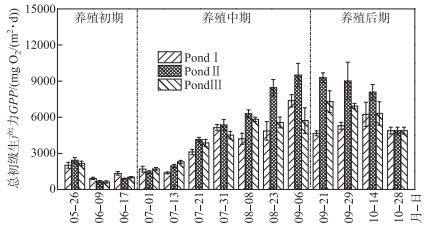
|
图 2 养殖期间闽江河口养殖塘水体总初级生产力的时间变化特征 Fig.2 Temporal variation of the gross primary productivity (GPP) in water column of three ponds in the Minjiang River estuary during the aquaculture period (from May to October) |
| 表 3 养殖塘水体浮游植物GPP、RP、NPP及GPP/RP系数变化特征* Tab. 3 Variation in GPP, RP, NPP and GPP/RP coefficient for phytoplankton in water column between ponds |
| 表 4 采样池塘、时间及其交互作用对养殖塘水体浮游植物GPP、RP、NPP及GPP/RP系数的影响 Tab. 4 Two-way ANOVA of the effects of sampling ponds, sampling time and their interactions on GPP, RP, NPP and GPP/RP coefficient for phytoplankton in water column |
呼吸消耗量RP在3个养殖塘水体间的时间变化特征亦基本一致(图 3),均呈现出养殖中期>养殖初期>养殖后期的特征. 养殖期间,养殖塘水柱日RP在PondⅠ、PondⅡ和PondⅢ变化范围分别为1003.16~5816.20、1186.25~6601.40和1186.25~7063.33 mg O2/(m2·d),均值分别为(3406.41±409.12)、(3901.50±491.61)和(3514.70±511.83) mg O2/(m2·d),呈现出PondⅡ>PondⅢ>PondⅠ的特征,但差异性不显著(P>0.05;表 3).
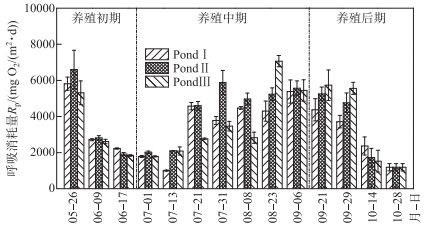
|
图 3 养殖期间闽江河口养殖塘水体呼吸消耗量的时间变化特征 Fig.3 Temporal variation of the respiration (RP) in water column of three ponds in the Minjiang River estuary during the aquaculture period (from May to October) |
养殖塘浮游植物水柱日净初级生产力NPP随养殖时间推移呈现出由负值到正值的变化特征(图 4). 养殖期间,养殖塘水柱日NPP在PondⅠ、PondⅡ和PondⅢ变化范围分别为-3807.70~3874.00、-4179.50~6362.96和-3142.10~4793.75 mg O2/(m2·d),均值分别为(385.94±55.58)、(1270.64±803.43)和(679.46±587.36) mg O2/(m2·d),呈现出PondⅡ>PondⅢ>PondⅠ的特征(P>0.05;表 3). 差异性分析结果显示,采样池塘、时间及其交互作用对养殖塘浮游植物水柱日NPP均具有显著影响(P < 0.001;表 4).
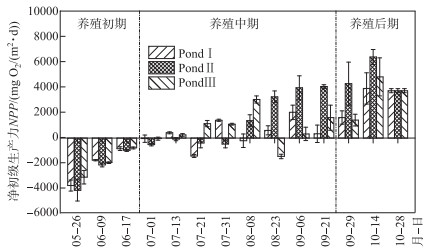
|
图 4 养殖期间闽江河口养殖塘水体净初级生产力时间变化特征 Fig.4 Temporal variation of the net primary productivity (NPP) in water column of three ponds in the Minjiang River estuary during the aquaculture period (from May to October) |
养殖期间,PondⅠ、PondⅡ和PondⅢ浮游植物水柱GPP/RP系数变化范围分别为0.34~4.32、0.23~5.67和0.23~6.26(图 5). 在时间变化上,3个池塘GPP/RP系数均呈现出养殖后期>养殖中期>养殖初期的特征(表 3),且在养殖初期GPP/RP系数小于1,但在养殖中后期均大于1. 在池塘间的变化上,养殖塘水柱GPP/RP系数在PondⅠ、PondⅡ和PondⅢ的均值分别为1.36±0.29、1.64±0.41和1.65±0.44,呈现出PondⅢ>PondⅡ>PondⅠ的特征(表 3). 差异性分析结果显示,采样池塘及时间对养殖塘浮游植物水柱GPP/RP系数具有显著影响(P < 0.05;表 4),但两者交互作用的影响不显著(P>0.05;表 4).
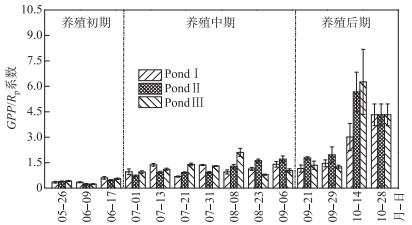
|
图 5 养殖期间闽江河口养殖塘水体总初级生产力/呼吸消耗量(GPP/RP)的时间变化特征 Fig.5 Temporal variation of the GPP/RP in water column of three ponds in the Minjiang River estuary during the aquaculture period (from May to October) |
Pearson相关分析结果显示(表 5),养殖塘浮游植物水柱GPP分别与盐度、pH、DO、NO3--N、NH3-N、TDN和Chl.a浓度呈显著正相关关系(P < 0.05或 < 0.01),与PO43-呈显著负相关关系(P < 0.01);水柱RP分别与水温、DO均呈显著正相关关系(P < 0.01),与NH3-N浓度呈显著负相关关系(P < 0.05);水柱NPP分别与pH、NO3--N、NH3-N、TDN和Chl.a浓度呈显著正相关关系(P < 0.05或 < 0.01),与水温呈显著负相关关系(P < 0.01).
| 表 5 养殖期间养殖塘水体浮游植物GPP、RP及NPP与环境变量的相关性矩阵 Tab. 5 The correlation matrix of GPP, RP and NPP and environmental variables at aquaculture ponds during the aquaculture period |
为了探析所测定的环境因子对养殖塘水体浮游植物GPP、RP及NPP变化的贡献大小,利用多元回归分析中的逐步回归法建立了GPP、RP及NPP与水体理化指标(水温—x1、盐度—x2、pH—x3、溶解氧DO—x4、NO3--N—x5、NH3-N—x6、TDN—x7、PO43-—x8和Chl.a—x9)之间的最优回归方程(表 6). 回归分析结果显示,在测定的环境因子中,养殖池塘水体浮游植物GPP变化主要受到Chl.a、NO3--N和NH3-N的影响;RP变化特征主要受到DO和水温的调控;NPP变化主要受到水体NH3-N、Chl.a和NO3--N浓度的影响.
| 表 6 养殖塘水体浮游植物GPP、RP及NPP与环境因子的多元逐步回归方程 Tab. 6 Multiple regression equations between GPP, RP, NPP and environmental factors in the aquaculture pond |
研究发现,不同养殖对象和不同养殖模式对养殖塘水体浮游植物初级生产力具有显著影响[15, 16, 30-32]. 但同种养殖模式及养殖对象下的不同养殖塘间的水体浮游植物初级生产力变化特征的研究鲜见报道. 本文通过对闽江河口区单养模式下的3个养虾塘进行研究,发现养殖期间池塘间的水体浮游植物GPP和NPP存在显著差异(P < 0.001;表 4),呈现出PondⅡ>PondⅢ>PondⅠ的特征(表 3). 此外,本研究发现,3个养虾塘水体浮游植物GPP和NPP具有显著时间变化特征,均呈现出随养殖时间推移显著增加的特征(图 2,4). 姜森颢等[13]在对刺参养殖池塘研究时,也发现池塘间GPP和NPP存在差异性的现象. 这些研究结果初步表明,开展大尺度养殖系统初级生产力评估及其相关模型参数构建时,有必要考虑池塘间水体初级生产力的变化特征.
研究表明,浮游植物初级生产力的变化主要受温度、光强、透明度、水深及营养盐浓度等环境因子的影响[16, 28, 33-36]. 就本研究而言,3个采样池塘地处同个河口区,水深都在1.3 m,故池塘间的水温、光强等环境因子并无显著差异性,其对池塘间水体浮游植物初级生产力的影响也因而较小. 相比之下,N营养盐(NO3--N、NH3-N)被发现在池塘间存在显著差异(P < 0.05;表 2),并且其浓度在3个池塘中均随养殖时间推移呈现出增加的特征[17]. 池塘间N营养盐差异性,究其原因,可能主要是因为不同池塘中虾对饵料的利用效率及其排泄能力存在差异所致;在时间变化上,养殖塘N营养盐随时间推移而增加,主要因为饵料投喂量及虾的觅食活动和排泄能力随养殖时间推移而增强致使N营养盐在水体形成“累积效应”[23, 37-38]. 有研究表明,浮游植物有机体组成平均N/P为16,若水体中N/P>16时,浮游植物则受磷限制;而当N/P < 16时,浮游植物则表现为氮限制[17, 39]. 按照此标准,PondⅠ、PondⅡ和PondⅢ养殖期间水体N/P的均值分别为4.92±4.62、8.50±10.96和5.25±4.57,表明N营养盐是研究区养殖塘水体浮游植物生长的主要限制因子. 营养盐直接影响到浮游植物初级生产力变化已被诸多研究所证实,并且多数研究发现两者呈现出正相关关系[13, 16, 33, 40]. 基于Pearson相关分析及多元逐步回归分析结果(表 5,6),我们亦发现NO3--N、NH3-N、Chl.a与GPP、NPP存在显著正相关关系,表明N营养盐浓度引起的浮游植物生物量差异是造成养殖塘间水体初级生产力差异并具有显著时间变化特征的主要原因.
3.2 养殖塘水体浮游植物的GPP/RP系数变化特征总初级生产力与生物呼吸耗氧量的比值(GPP/RP系数)称为浮游植物群落代谢率,是反映水体环境生产力结构的重要指标. 整个养殖期间,PondⅠ、PondⅡ和PondⅢ的GPP/RP系数均值分别为1.36±0.29、1.64±0.41和1.65±0.44,均高于天然水体GPP/RP系数(接近1)[41]. GPP/RP系数在3个池塘间无显著差异(P>0.05;表 3,4),但其随养殖期推移具有显著的时间变化特征(P < 0.05;图 5,表 4). 具体而言,3个池塘水体养殖期间的GPP/RP系数变化范围介于0.23~6.26之间,其中GPP/RP系数在养殖初期(5—7月)小于1,而在养殖中后期大于1. 通常,GPP/RP系数>1表明水体以自养过程为主导[40, 42],养殖水体分解能力较弱、物质循环速率低且初级生产力未被充分利用[16];GPP/RP系数 < 1表明水体以异养生产过程为主[40, 42],水中有机物分解过程占优势可能会导致水体溶氧状况恶化[10, 13]. 基于以上分析,闽江河口区养殖塘水体生产力随养殖时间推移呈现出由异养生产过程为主转变为由自养生产过程为主.
3.3 养殖塘初级生产力与虾产量间的关系浮游植物作为初级生产者,是浮游动物觅食过程中所摄取的重要饵料来源,对水产品或渔业生产具有重要意义. 马志强等[43]基于对辽东湾北部海区的调查数据,发现水体浮游植物初级生产力分布具有明显的区域特征,且与渔业资源关系密切. 本研究中,3个池塘的虾产量表现为PondⅡ (9500 kg) >PondⅢ (8000 kg)>PondⅠ (7000 kg),与水体GPP、NPP在池塘间的变化特征基本一致(表 3). 相关分析结果显示,3个池塘的虾产量分别与水体GPP(图 6a)、NPP(图 6b)呈现显著正相关关系(P < 0.01). 这些结果初步表明,较高初级生产力是支撑养殖塘具有较高虾产量的重要条件. 因此,今后有必要在不同河口区开展相关研究工作,进一步精确量化养殖塘虾产量与浮游植物生产力间的关系,为提高养殖塘系统稳定性及其生产量提供理论依据和参考.
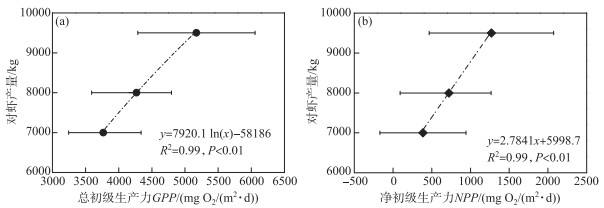
|
图 6 养殖塘对虾产量与水体GPP及NPP的相关关系 Fig.6 Relationships between harvested shrimp yield and GPP and NPP at mariculture ponds |
本研究中养虾塘浮游植物GPP均值为4.38 g O2/(m2·h),低于我国绝大多数海水和淡水环境下的养殖系统浮游植物GPP[10, 13, 16, 44-48](表 7),也低于赵文等[49]对盐碱池塘浮游植物GPP的研究结果. 基于表 7列出的数据,海水和淡水环境下的养殖系统水体浮游植物GPP均值分别为4.12和7.98 g O2/(m2·h),呈现出前者小于后者的特征. 从该结果来看,本研究中与海水环境下的养殖系统浮游植物GPP均值较接近,但明显低于淡水环境下的养殖系统浮游植物GPP均值. 与国外高产淡水池塘(GPP为10~20 g O2/(m2·h))相比[50],本研究中的虾塘水体浮游植物GPP亦明显偏低.
| 表 7 不同养殖塘水体浮游植物初级生产力的比较 Tab. 7 Comparison of primary productivity of phytoplankton in water column in different aquaculture ponds |
研究期间,闽江口养虾塘GPP/RP系数均值为1.55,略高于我国其它淡水环境下的养殖系统[9, 45-46]和海水环境下的对虾养殖塘[30, 44]浮游植物GPP/RP系数,但明显低于海水环境下的刺参养殖池塘GPP/RP系数[13, 16]. 相比天然水体GPP/RP系数(接近1),无论是淡水还是海水环境下的养殖系统GPP/RP系数通常都偏高,表明养殖生态系统稳定性较差,进而对其生产量具有负面影响. 因此,如何充分利用养殖系统中的初级生产力,使其更迅速地进入下一营养级,进而被养殖动物所利用,以提高养殖系统稳定性及其生产量是今后值得深入开展的研究[13].
4 结论研究期间,闽江河口区水产养虾塘水体浮游植物初级生产力在池塘间存在显著差异,并且具有显著的时间变化特征,呈现出随养殖阶段推移而增加的趋势. GPP/RP系数显示,闽江河口区养殖塘水体生产力由养殖初期的异养生产过程为主转变为养殖中后期的自养生产过程为主. 多元逐步回归分析显示,养殖塘间水体初级生产力的差异性及其时间变化特征主要受N营养盐和Chl.a浓度的影响. 这些研究结果初步表明,开展大尺度滨海水产养殖塘初级生产力评估及其相关模型参数构建时,需考虑池塘间水体初级生产力的时间变化特征.
致谢: 感谢福建师范大学亚地理科学学院赵光辉、李玲和张逸飞等同学在野外样品采集中给予的帮助.
| [1] |
FAO. FAO Yearbook. Fishery and Aquaculture Statistics 2018/FAO annuaire, 2020. Rome. DOI: 10.4060/cb1213t.
|
| [2] |
Hu Z, Lee JW, Chandran K et al. Nitrous oxide (N2O) emission from aquaculture: A review. Environmental Science & Technology, 2012, 46(12): 6470-6480. DOI:10.1021/es300110x |
| [3] |
Aubin J, Callier M, Rey-Valette H et al. Implementing ecological intensification in fish farming: Definition and principles from contrasting experiences. Reviews in Aquaculture, 2019, 11(1): 149-167. DOI:10.1111/raq.12231 |
| [4] |
Yang P, Bastviken D, Lai DYF et al. Effects of coastal marsh conversion to shrimp aquaculture ponds on CH4 and N2O emissions. Estuarine, Coastal and Shelf Science, 2017, 199: 125-131. DOI:10.1016/j.ecss.2017.09.023 |
| [5] |
Ren CY, Wang ZM, Zhang YZ et al. Rapid expansion of coastal aquaculture ponds in China from Landsat observations during 1984-2016. International Journal of Applied Earth Observation and Geoinformation, 2019, 82: 101902. DOI:10.1016/j.jag.2019.101902 |
| [6] |
Hargreaves JA. Nitrogen biogeochemistry of aquaculture ponds. Aquaculture, 1998, 166(3/4): 181-212. DOI:10.1016/S0044-8486(98)00298-1 |
| [7] |
Feng DY, Qian D. Prevalence study on Penaeus vannamei infected with WSD and TS during 2005-2009. South China Fisheries Science, 2011, 7(1): 78-83. [冯东岳, 钱冬. 2005 2009年凡纳滨对虾白斑综合征和桃拉综合征的流行情况分析. 南方水产科学, 2011, 7(1): 78-83. DOI:10.3969/j.issn.2095-0780.2011.01.013] |
| [8] |
Yang P, Tan LS, Jin BS et al. Variation of nutrients and chlorophyll a contents in the shrimp ponds of Jiulong River estuary and their influencing factors. Wetland Science, 2017, 15(6): 794-801. [杨平, 谭立山, 金宝石等. 九龙江河口区养虾塘水体营养盐与叶绿素a含量的变化特征及影响因素. 湿地科学, 2017, 15(6): 794-801.] |
| [9] |
Zhou B, Gong Q, Lu H et al. The primary productivity of phytoplankton in Acipenser dabryanus broodstock culture pond. Journal of Hydroecology, 2014, 35(1): 39-45. [周波, 龚全, 卢华等. 达氏鲟亲鱼培育池浮游植物初级生产力的研究. 水生态学杂志, 2014, 35(1): 39-45. DOI:10.15928/j.1674-3075.2014.01.013] |
| [10] |
Yan XW, He ZH. Studies on primary production of phytoplankton in shrimp ponds. Journal of Fisheries of China, 1997, 21(3): 288-295. [阎喜武, 何志辉. 虾池浮游植物初级生产力的研究. 水产学报, 1997, 21(3): 288-295.] |
| [11] |
Wang J, Liang YL. An estimation of the potential productivity and stocking rate of fingerlings of silver and bighead carps in Dong hu by means of phytoplankton production. Journal of Fisheries of China, 1981, 5(4): 343-350. [王骥, 梁彦龄. 用浮游植物的生产量估算武昌东湖鲢鳙生产潜力与鱼种放养量的探讨. 水产学报, 1981, 5(4): 343-350.] |
| [12] |
Terziyski D, Grozev G, Kalchev R et al. Effect of organic fertilizer on plankton primary productivity in fish ponds. Aquaculture International, 2007, 15(3/4): 181-190. DOI:10.1007/s10499-007-9086-1 |
| [13] |
Jiang SH, Zhou YB, Tang BP et al. Annual variations of the primary productivity and its size-fractioned structure in culture ponds of Apostichopus japonicus Selenka. Acta Ecologica Sinica, 2014, 34(7): 1698-1706. [姜森颢, 周一兵, 唐伯平等. 刺参养殖池塘初级生产力及其粒级结构周年变化. 生态学报, 2014, 34(7): 1698-1706.] |
| [14] |
Chen Y, Dong S, Bai Y et al. Carbon budgets from mariculture ponds without a food supply. Aquaculture Environment Interactions, 2018, 10: 465-472. DOI:10.3354/aei00279 |
| [15] |
Guo K, Zhao W, Jiang ZQ et al. A study of organic carbon, nitrogen and phosphorus budget in jellyfish-shellfish-fish-prawn polyculture ponds. Aquaculture Research, 2017, 48(1): 68-76. DOI:10.1111/are.12861 |
| [16] |
Sun GW, Zhou W, Dang ZQ et al. Annual change of primary productivity in Apostichopus japonicus ponds by three water quality regulations. Journal of Fisheries of China, 2020, 44(4): 632-641. [孙广伟, 周玮, 党子乔等. 3种水质调控方式下刺参池塘初级生产力的周年变化. 水产学报, 2020, 44(4): 632-641.] |
| [17] |
Zhao GH, Yang P, Tang C et al. Variation of DOC, nutrients and chlorophyll a contents in shrimp ponds of Minjiang River Estuary. South China Fisheries Science, 2020, 16(3): 70-78. [赵光辉, 杨平, 唐晨等. 闽江河口养虾塘水体可溶性有机碳、营养盐和叶绿素a浓度变化特征. 南方水产科学, 2020, 16(3): 70-78.] |
| [18] |
Yang P, Zhang YF, Lai DYF et al. Fluxes of carbon dioxide and methane across the water-atmosphere interface of aquaculture shrimp ponds in two subtropical estuaries: The effect of temperature, substrate, salinity and nitrate. Science of the Total Environment, 2018, 635: 1025-1035. DOI:10.1016/j.scitotenv.2018.04.102 |
| [19] |
Tong C, Huang JF, Hu ZQ et al. Diurnal variations of carbon dioxide, methane, and nitrous oxide vertical fluxes in a subtropical estuarine marsh on neap and spring tide days. Estuaries and Coasts, 2013, 36(3): 633-642. DOI:10.1007/s12237-013-9596-1 |
| [20] |
Li L, Yang P, Tan LS et al. CH4 and N2O production potentials of sediments in Cyperus malaccensis marsh and reclaimed shrimp pond of Minjiang River estuary. Chinese Journal of Ecology, 2020, 39(2): 645-654. [李玲, 杨平, 谭立山等. 闽江河口短叶茳芏湿地及围垦养虾塘的沉积物CH4和N2O产生潜力. 生态学杂志, 2020, 39(2): 645-654. DOI:10.13292/j.1000-4890.202002.002] |
| [21] |
Yang P, Yang H, Lai DYF et al. Large contribution of non-aquaculture period fluxes to the annual N2O emissions from aquaculture ponds in Southeast China. Journal of Hydrology, 2020, 582: 124550. DOI:10.1016/j.jhydrol.2020.124550 |
| [22] |
Páez-Osuna F, Guerrero-Galván SR, Ruiz-Fernández AC et al. Fluxes and mass balances of nutrients in a semi-intensive shrimp farm in north-western Mexico. Marine Pollution Bulletin, 1997, 34(5): 290-297. DOI:10.1016/S0025-326X(96)00133-6 |
| [23] |
Yang P, Lai DYF, Jin BS et al. Dynamics of dissolved nutrients in the aquaculture shrimp ponds of the Min River estuary, China: Concentrations, fluxes and environmental loads. Science of the Total Environment, 2017, 603/604: 256-267. DOI:10.1016/j.scitotenv.2017.06.074 |
| [24] |
Zhang L, Wang L, Yin KD et al. Pore water nutrient characteristics and the fluxes across the sediment in the Pearl River estuary and adjacent waters, China. Estuarine, Coastal and Shelf Science, 2013, 133: 182-192. DOI:10.1016/j.ecss.2013.08.028 |
| [25] |
Jeffrey SW, Humphrey GF. New spectrophotometric equations for determining chlorophylls a, b, c1 and c2 in higher plants, algae and natural phytoplankton. Biochemie Und Physiologie Der Pflanzen, 1975, 167(2): 191-194. DOI:10.1016/S0015-3796(17)30778-3 |
| [26] |
Zhang Y, Wang YJ, Wang YQ et al. Spatial distribution and correlation of environmental factors and chlorophyll a concentrations in the Bohai Sea during the summer of 2013. Marine Science Bulletin, 2016, 35(5): 571-578. [张莹, 王玉珏, 王跃启等. 2013年夏季渤海环境因子与叶绿素a的空间分布特征及相关性分析. 海洋通报, 2016, 35(5): 571-578.] |
| [27] |
Diana JS, Lin CK, Schneeberger PJ. Relationships among nutrient inputs, water nutrient concentrations, primary production, and yield ofOreochromis niloticus in ponds. Aquaculture, 1991, 92: 323-341. DOI:10.1016/0044-8486(91)90038-9 |
| [28] |
Feng SM, Liu DY, Li DJ et al. Analysis on the temporal and spatial distribution of the primary productivity and its influencing factors in Lake Taiping (Reservoir), Anhui Province. J Lake Sci, 2016, 28(6): 1361-1370. [冯世敏, 刘冬燕, 李东京等. 安徽太平湖水库初级生产力时空分布及分析. 湖泊科学, 2016, 28(6): 1361-1370. DOI:10.18307/2016.0622] |
| [29] |
Huang LC, Zhou YY, Zhou QC et al. Temporal-spatial variation in phytoplankton primary production and its influencing factors in Lake Chenghai on the Yunnan Plateau, China. J Lake Sci, 2019, 31(5): 1424-1436. [黄立成, 周远洋, 周起超等. 云南程海浮游植物初级生产力的时空变化及其影响因子. 湖泊科学, 2019, 31(5): 1424-1436. DOI:10.18307/2019.0508] |
| [30] |
Wang Y, Zhang HY. Studies on primary production in seawater experimental enclosures with different monoculture or polyculture. Journal of Fisheries of China, 1999, 23(2): 138-143. [王岩, 张鸿雁. 不同单养和混养海水实验围隔初级生产力的研究. 水产学报, 1999, 23(2): 138-143.] |
| [31] |
Zhang K, Yu DG, Li ZF et al. Influence of eco-substrate addition on organic carbon, nitrogen and phosphorus budgets of intensive aquaculture ponds of the Pearl River, China. Aquaculture, 2020, 520: 734868. DOI:10.1016/j.aquaculture.2019.734868 |
| [32] |
Zhang K, Tian XL, Dong SL et al. An experimental study on the budget of organic carbon in polyculture systems of swimming crab with white shrimp and short-necked clam. Aquaculture, 2016, 451: 58-64. DOI:10.1016/j.aquaculture.2015.08.029 |
| [33] |
Xiong Q, Huang LC, Ye SW et al. The seasonal variations and spatial distribution of the primary productivities of phytoplankton in the Three Gorges reservoir. Acta Hydrobiologica Sinica, 2015, 39(5): 853-860. [熊倩, 黄立成, 叶少文等. 三峡水库浮游植物初级生产力的季节变化与空间分布. 水生生物学报, 2015, 39(5): 853-860.] |
| [34] |
Ryther JH. Photosynthesis and fish production in the sea. Science, 1969, 166(3901): 72-76. DOI:10.1126/science.166.3901.72 |
| [35] |
Sukla B, Patra AK, Panda RP. Primary production in River Birupa, India. Proceedings of the National Academy of Sciences, India Section B: Biological Sciences, 2013, 83(4): 593-602. DOI:10.1007/s40011-013-0165-y |
| [36] |
Zhang YL, Qin BQ, Chen WM et al. Experimental study on underwater light intensity and primary productivity caused by variation of total suspended matter. Advances in Water Science, 2004, 15(5): 615-620. [张运林, 秦伯强, 陈伟民等. 悬浮物浓度对水下光照和初级生产力的影响. 水科学进展, 2004, 15(5): 615-620. DOI:10.3321/j.issn:1001-6791.2004.05.014] |
| [37] |
Yu HB, Gao QF, Sun YJ et al. Dynamic change and circulation of nutrients in polyculture system of sea cucumber (Apostichopus japonicus) and shrimp (Fenneropenaeus chinensis). Periodical of Ocean University of China, 2013, 43(9): 25-32. [于海波, 高勤峰, 孙永军等. 刺参-对虾复合养殖系统主要营养盐动态变化及循环过程的研究. 中国海洋大学学报: 自然科学版, 2013, 43(9): 25-32.] |
| [38] |
Castillo Soriano FA, Ibarra Junquera V, Escalante Minakata P et al. Nitrogen dynamics model in zero water exchange, low salinity intensive ponds of white shrimp, Litopenaeus vannamei, at Colima, Mexico. Latin American Journal of Aquatic Research, 2013, 41(1): 68-79. DOI:10.3856/vol41-issue1-fulltext-5 |
| [39] |
Redfield AC. The biological control of chemical factors in the environment. Science Progress, 1960, 11: 150-170. |
| [40] |
Guo JS, Li W, Li Z et al. Spring primary productivity in Xiaojiang River backwater area in the Three Gorges Reservoir. J Lake Sci, 2011, 23(4): 591-596. [郭劲松, 李伟, 李哲等. 三峡水库小江回水区春季初级生产力. 湖泊科学, 2011, 23(4): 591-596. DOI:10.18307/2011.0415] |
| [41] |
Dong SL, Zhao W eds. Aquatic ecology for aquaculture. Beijing: China Agriculture Press, 2004. [董双林, 赵文. 养殖水域生态学. 北京: 中国农业出版社, 2004.]
|
| [42] |
Giorgio PAD, Peters RH. Balance between phytoplankton production and plankton respiration in lakes. Canadian Journal of Fisheries and Aquatic Sciences, 1993, 50(2): 282-289. DOI:10.1139/f93-032 |
| [43] |
Ma ZQ, Zhou ZC, Xue K et al. The relationship between the primary production and fishery resources in the northern waters of Liaodong bay. Fisheries Science, 2004, 23(4): 12-15. [马志强, 周遵春, 薛克等. 辽东湾北部海区初级生产力与渔业资源的关系. 水产科学, 2004, 23(4): 12-15.] |
| [44] |
Shen YC, Xiong BX, Ye FL et al. Studies on the phytoplankton and primary productivity in ponds of Penaeus vannamei. Reservoir Fisheries, 2004, 25(3): 7-10. [申玉春, 熊邦喜, 叶富良等. 南美白对虾高位池浮游生物和初级生产力的研究. 水利渔业, 2004, 25(3): 7-10. DOI:10.3969/j.issn.1003-1278.2004.03.003] |
| [45] |
He ZH. Analysis on the fish pond ecosystems in Zhenlai fish farm of Jilin Province. Journal of Fisheries of China, 1993, 17(1): 24-35. [何志辉. 吉林镇贲养鱼场鱼池生态系的分析. 水产学报, 1993, 17(1): 24-35.] |
| [46] |
Yao HL, Wu NW, Gu YL et al. Primary productivity and energy conversion efficiencies for silver carp and bighead carp in high-output fish ponds with the black carp as the major species for culture. Acta Hydrobiologica Sinica, 1990, 14(2): 114-128. [姚宏禄, 吴乃薇, 顾月兰等. 主养青鱼高产池塘的初级生产力及其能量转化为鲢、鳙产量的效率. 水生生物学报, 1990, 14(2): 114-128.] |
| [47] |
Lu ZY, Wang LQ, Ji GH et al. Control of Dianshan Lake eutrophication based on the primary productivity of silver carp and bighead carp. Chinese Journal of Ecology, 2010, 29(7): 1365-1370. [卢子园, 王丽卿, 季高华等. 淀山湖基于初级生产力的鲢鳙富营养化控制. 生态学杂志, 2010, 29(7): 1365-1370. DOI:10.13292/j.1000-4890.2010.0227] |
| [48] |
Xiao ZG, Liu YX, Wang XG et al. Primary productivity and fish productivity assessment in Shuifeng Reservoir. Chinese Journal of Fisheries, 2017, 30(4): 28-32. [肖祖国, 刘义新, 王晓光等. 水丰水库初级生产力及鲢鱼产力评估. 水产学杂志, 2017, 30(4): 28-32. DOI:10.3969/j.issn.1005-3832.2017.04.006] |
| [49] |
Zhao W, Dong SL, Li DS et al. The primary productivity of phytoplankton in saline-alkaline ponds. Acta Hydrobiologica Sinica, 2003, 27(1): 47-54. [赵文, 董双林, 李德尚等. 盐碱池塘浮游植物初级生产力的研究. 水生生物学报, 2003, 27(1): 47-54. DOI:10.3321/j.issn:1000-3207.2003.01.010] |
| [50] |
Colman J, Edwards P. Feeding pathways and environmental constraints in waste-fed aquaculture: balance and optimization In: Moriaity DJW, Pullin RSV eds. Detritus and microbial ecology in aquaculture. ICLARM conference Proceeding International center for Living Aquatic Resources. Management Manila Philippines, 1987: 14-420.
|
 2022, Vol. 34
2022, Vol. 34 

